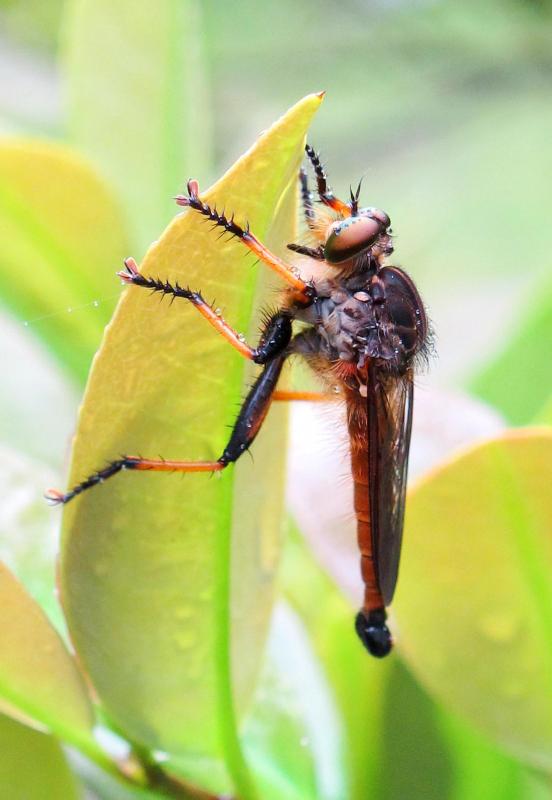The word “insectageddon,” which has been around since at least 2017, describes what seems to be an alarming and ongoing collapse in the number and variety of insects on Earth.
Anecdotal and empirical evidence supports this narrative of decline.
“People often ask: Why can’t we hear crickets chirping in our yards or among roadside vegetation? The soundscape of the countryside has changed because farming landscapes have changed,” says Yang Jeng-tze (楊正澤), a professor in the Department of Entomology, National Chung Hsing University (NCHU).

Photo: Steven Crook
A meta-analysis of 166 long-term surveys across 1,668 globally distributed sites (including four in Taiwan) published in Science last April found that rates of decline vary from one place to another, but overall there appears to be an almost one percent loss of terrestrial insect biomass every year.
“That’s less than what other researchers have reported, but it’s based on a wider collection of data and stricter requirements for what constitutes good data. It’s still a huge loss,” says Matan Shelomi, an assistant professor in the Department of Entomology, National Taiwan University.
“One should note that the data from the 2020 meta-analysis mostly comes from protected areas, meaning the areas with the weakest declines. The actual global decline in insect abundance is probably worse than one percent,” he adds.

Photo: Steven Crook
“The losses seem to be worse in North America, but, again, there’s much more data from there. The strength of the trends may change as we do more research in other nations. The effect also seems to be stronger in temperate climates and deserts,” Shelomi adds.
Years before “insectageddon” entered the lexicon, Taiwanese scientists noticed a striking decline in carrion beetle numbers inside one protected area with a semi-temperate climate.
In Hapen Nature Reserve (哈盆自然保留區), which straddles the New Taipei City-Yilan border, researchers used both baited and non-baited pitfall traps in forest and meadow habitats to tally the insects. Comparing results from baited traps in the forest habitat in 2001 with those in 2006 and 2007, “showed that species richness and the number of individuals progressively decreased, with the number of individuals decreasing by 10 percent in 2006 and 14 percent in 2007,” the researchers reported in a 2013 issue of Taiwan Journal of Forest Science.

Photo: Steven Crook
In the meadow — where greater exposure to sunlight and larger day/night temperature differences make the impact of climate warming more pronounced — the population of eight species increased in 2006, yet “the total number of beetles of all species collected was 63.7 percent lower in 2006 than in 2001.”
Annual average temperatures at the survey sites in 2001 and 2006-2007 were 18.2 and 18.6 degrees Celsius, respectively. Warmer weather caused the bait (dead mice, in this instance) to decompose faster. This shortened the periods in which insects could locate and feed on the carcasses, thus reducing the numbers of species and individuals able to make use of them, the researchers concluded.
WHY THIS MATTERS

Photo: Steven Crook
The tremendous importance of insects to the ecosphere is well known. Bees and butterflies pollinate plants. Ants and beetles disperse seeds, and are important to soil health. Mosquitoes are a key food for bats. Birds eat flies and grubs, while Taiwan’s pangolins subsist on termites and ants.
Taiwanese don’t eat insects, but Odontotermes obesus indirectly provides gourmets in the south with a delicious seasonal food. In its nests, this termite species — also found in a few other countries in Asia — cultivates Macrolepiota albuminosa, a mushroom likened by those who gather and eat it to shredded chicken meat. So far, all efforts to farm Macrolepiota albuminosa have ended in failure.
Environmental awareness and policy have come a long way in Taiwan, but it’s inconceivable that, on an island so crowded with people, factories and farms, insect populations aren’t under great pressure.
Ecological projects in Taipei have had some success in bringing fireflies and tadpole-eating jumbo dragonflies back into the city. Also, wild butterflies are no longer harvested in vast numbers. According to Threatened Swallowtail Butterflies of the World: The IUCN Red Data Book — published in 1985 — throughout the 1960s, Taiwan turned between 15 million and 500 million butterflies per year into laminated ornaments and decorations.
The book points out that, while the trade ignored the majority of local lepidopteran species, this didn’t mean they were safe. Then, as now, “the major threats to Taiwan’s butterflies undoubtedly come from habitat destruction for agriculture and forestry… urbanization, air pollution and pesticides are taking their toll.”
“I always monitor insect diversity, and modern cropping systems have caused a decrease in biodiversity. Some species have been lost, and others have become vulnerable. I work mainly with crickets, and for those species living close to humans, farming activity is the main cause of concern,” says NCHU’s Yang.
Shelomi likens urban areas or farmlands near forests to electric fences.
“With their insecticides and inhospitable terrain, they kill anything that leaves the forest. But the insects don’t know this, and they keep flying in,” he says.
He points out that freshwater insects are doing much better than their terrestrial relatives.
“There’s been an average one percent increase in abundance every year. The reasons for this include reduced water pollution, as countries have fought pollution and illegal dumping of waste into water,” says the insect physiology and microbiology specialist.
North America’s aquatic insect populations have grown since the passage of the 1972 Clean Water Act in the US. In Central Asia, they benefited from the collapse of the USSR and its heavy industries. In Taiwan, stricter wastewater rules, as well as an exodus of polluting industries to China and Southeast Asia, may have made a difference.
“On the other hand, the increase may be due to increased microbe productivity in the water due to fertilizer runoff from fields,” Shelomi explains. “It’s also important not to let the good news for aquatic insects overshadow the bad news for terrestrial insects. Less than three percent of the Earth’s surface is freshwater.”
WELCOME AND UNWELCOME BUGS
Higher temperatures could be a mixed blessing for Taiwan’s rice farmers, who must remain vigilant against various beetles, borers, leaffolders, planthoppers and weevils.
The authors of a 2010 paper in Crop, Environment & Bioinformatics warn that global warming may, if host plants are available, result in conditions more suitable for overwintering by various non-native pests. This would make it more likely that their populations could grow and damage crops.
For certain pests, such as the green rice leafhopper, Taiwan is the northernmost limit of distribution. As the climate warms, it could become a more serious problem. There’s also a danger that the Asian rice gall midge and other pests common in Southeast Asia might establish themselves here.
For the smaller brown planthopper, rice leaf beetle, and rice water weevil, Taiwan is believed to be their southernmost limit of distribution. Higher summer temperatures might cause them to disappear altogether — and, at the same time, lead to a proliferation of the tiny fairyflies that are natural enemies of planthoppers that feed on rice plants.
The paper’s authors think that while the occurrence of and damage by rice insect pests in Taiwan “will not change greatly in the near future under global warming… long-term monitoring [of] the population dynamics of these insect pests is very important.”
Shelomi doesn’t think “insectageddon” will lead to a collapse of life on Earth.
“Climate change is killing polar bears and deforestation is killing Formosan black bears, but the dengue mosquito that prefers to live among humans in hot climates is doing better than ever,” he says.
“I doubt cockroach biomass is decreasing. They love our cities. But that’s just Periplaneta americana, the big cockroach seen on the streets of Taipei. There are many other cockroaches that only live in the forests, some with beautiful blue or black or red or green colors, and their abundance is probably going down. The species that we don’t see are the ones we’ll lose, but the ones that annoy us aren’t threatened. Nature will continue, but in a way that’s worse for us,” he concludes.
Steven Crook, the author or co-author of four books about Taiwan, has been following environmental issues since he arrived in the country in 1991. He drives a hybrid and carries his own chopsticks.

Late last month Philippines Foreign Affairs Secretary Theresa Lazaro told the Philippine Senate that the nation has sufficient funds to evacuate the nearly 170,000 Filipino residents in Taiwan, 84 percent of whom are migrant workers, in the event of war. Agencies have been exploring evacuation scenarios since early this year, she said. She also observed that since the Philippines has only limited ships, the government is consulting security agencies for alternatives. Filipinos are a distant third in overall migrant worker population. Indonesia has over 248,000 workers, followed by roughly 240,000 Vietnamese. It should be noted that there are another 170,000

Hannah Liao (廖宸萱) recalls the harassment she experienced on dating apps, an experience that left her frightened and disgusted. “I’ve tried some voice-based dating apps,” the 30-year-old says. “Right away, some guys would say things like, ‘Wanna talk dirty?’ or ‘Wanna suck my d**k?’” she says. Liao’s story is not unique. Ministry of Health and Welfare statistics show a more than 50 percent rise in sexual assault cases related to online encounters over the past five years. In 2023 alone, women comprised 7,698 of the 9,413 reported victims. Faced with a dating landscape that can feel more predatory than promising, many in

“This is one of those rare bits of TikTok fitness advice with a lot of truth behind it,” says Bethan Crouse, performance nutritionist at Loughborough University. “Sometimes it’s taken a bit too literally, though! You see people chugging protein drinks as they’re scanning out of their gym.” Crouse recommends the athletes she works with consume 20-30g of protein within 30-60 minutes of finishing a resistance training session. “The act of exercising our muscles increases the breakdown of muscle proteins,” she says. “In order to restore, or hopefully improve them — and get gains such as increased muscle mass or strength —

“Far from being a rock or island … it turns out that the best metaphor to describe the human body is ‘sponge.’ We’re permeable,” write Rick Smith and Bruce Lourie in their book Slow Death By Rubber Duck: The Secret Danger of Everyday Things. While the permeability of our cells is key to being alive, it also means we absorb more potentially harmful substances than we realize. Studies have found a number of chemical residues in human breast milk, urine and water systems. Many of them are endocrine disruptors, which can interfere with the body’s natural hormones. “They can mimic, block